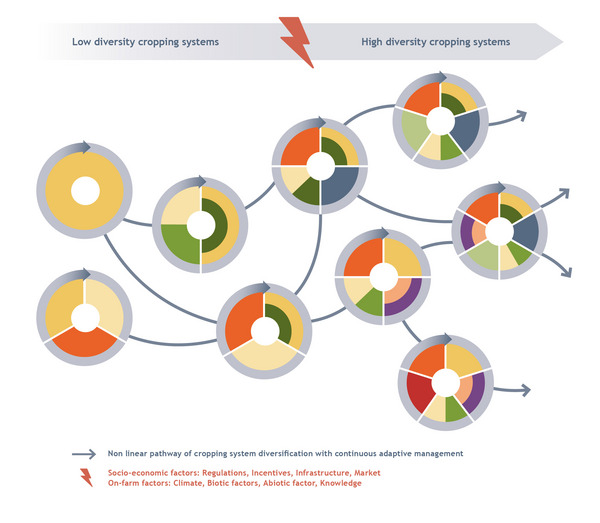Current European cropping systems have benefited from research and development efforts carried out over several decades while less effort has been dedicated to diversification due to sociotechnical lock-ins;
However, data from scientific literature, field experiments and case studies has shown that it is possible to build more diversified cropping systems that combine similar or even higher production levels and gross margins than the current systems, with reduced inputs (nitrogen and pesticides) and lower environmental impacts (see, for example, information on the analyses of crop diversification experinces, field experiments, and a life-cycle assessment).
However, trade-offs in performance often remain, mainly due to the following factors:
- Crop diversification may be too limited (e.g., only substitution between crops rather than re-designing systems)
- Some diversification strategies have not proven to be appropriate for certain local factors (e.g., pedo-climate, markets)
- Farmers reluctance to adapt input levels and crop management according to the expected benefits of diversification (e.g., reduction of nitrogen inputs on a cereal crop following a legume crop)
- Diversification crops are generally not as well mastered, and are less competitive than major crops, due to less investments from most actors in the agri-food system
DiverIMPACTS has identified factors, or “ingredients”, that increase the chance of successfully diversify cropping systems.
Our results support a gradual introduction of diversification/minor crops and diversification practices rather than a breakthrough from current systems. It is paramount that crop diversification be tailor-made at the cropping system and landscape level to consider evolving pedo-climatic and socio-economic factors (see link to DiverIMPACTS policy brief below).
Gradual introduction and adaptation to local situations call for moving from crop-specific and practice-oriented measures to a dynamic pathway driven by continuous monitoring of diversification performances (e.g., SMART-Diversification Tool). The use of the sustainability assessment tools is also crucial to increase the awareness of stakeholders and of society at large about trade-offs and limits of prescriptive solutions;
More broadly, crop diversification requires coordination between all actors in the agri-food system to effectively engage in the research and development that minor crops require, to create and maintain sustainable value chains. See, for example, the articles on:
- Understanding anchoring processes in the DiverIMPACTS case studies
- The importance of coordination and tools for framing collaboration to develop crop diversification value chains
Further information
zenodo.org: DiverIMPACTS policy brief - Promoting crop diversification for more sustainable agri-food systems

 tap and then scroll down to the Add to Home Screen command.
tap and then scroll down to the Add to Home Screen command.